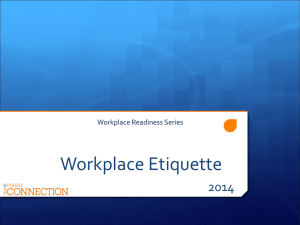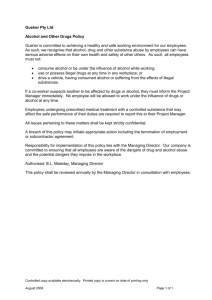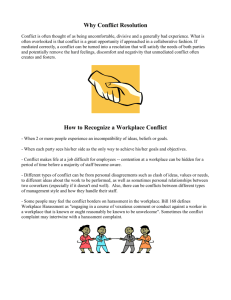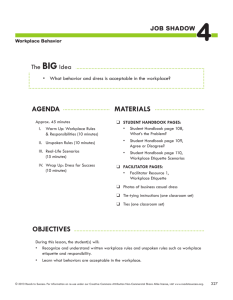Business Etiquette Quiz
advertisement
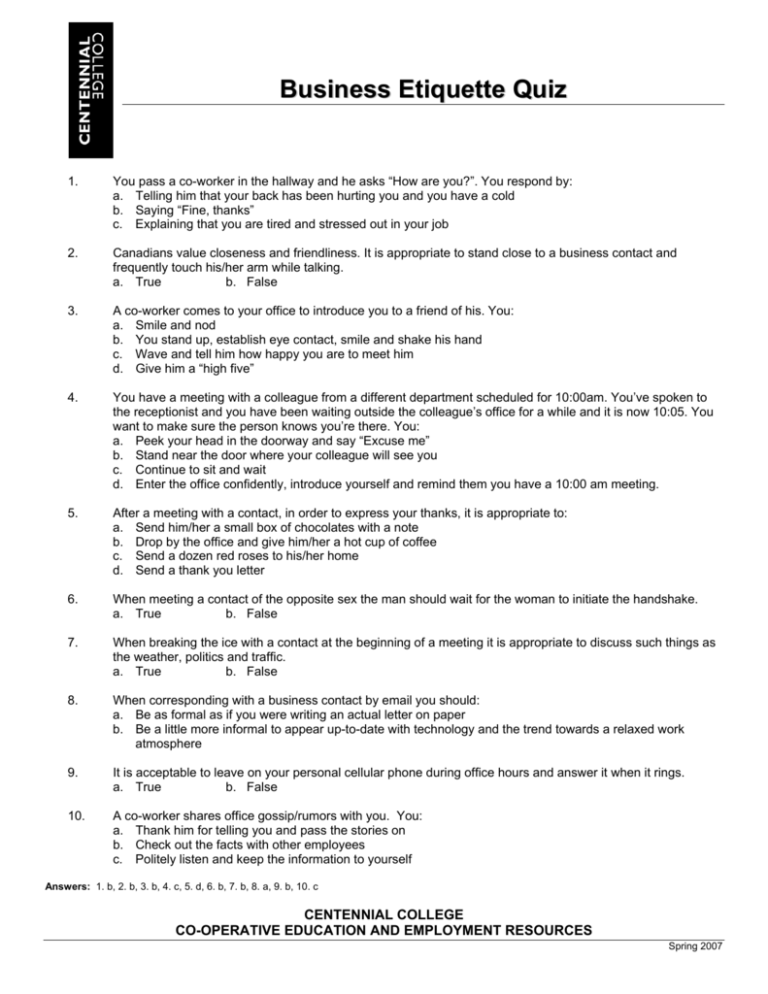
Business Etiquette Quiz 1. You pass a co-worker in the hallway and he asks “How are you?”. You respond by: a. Telling him that your back has been hurting you and you have a cold b. Saying “Fine, thanks” c. Explaining that you are tired and stressed out in your job 2. Canadians value closeness and friendliness. It is appropriate to stand close to a business contact and frequently touch his/her arm while talking. a. True b. False 3. A co-worker comes to your office to introduce you to a friend of his. You: a. Smile and nod b. You stand up, establish eye contact, smile and shake his hand c. Wave and tell him how happy you are to meet him d. Give him a “high five” 4. You have a meeting with a colleague from a different department scheduled for 10:00am. You’ve spoken to the receptionist and you have been waiting outside the colleague’s office for a while and it is now 10:05. You want to make sure the person knows you’re there. You: a. Peek your head in the doorway and say “Excuse me” b. Stand near the door where your colleague will see you c. Continue to sit and wait d. Enter the office confidently, introduce yourself and remind them you have a 10:00 am meeting. 5. After a meeting with a contact, in order to express your thanks, it is appropriate to: a. Send him/her a small box of chocolates with a note b. Drop by the office and give him/her a hot cup of coffee c. Send a dozen red roses to his/her home d. Send a thank you letter 6. When meeting a contact of the opposite sex the man should wait for the woman to initiate the handshake. a. True b. False 7. When breaking the ice with a contact at the beginning of a meeting it is appropriate to discuss such things as the weather, politics and traffic. a. True b. False 8. When corresponding with a business contact by email you should: a. Be as formal as if you were writing an actual letter on paper b. Be a little more informal to appear up-to-date with technology and the trend towards a relaxed work atmosphere 9. It is acceptable to leave on your personal cellular phone during office hours and answer it when it rings. a. True b. False 10. A co-worker shares office gossip/rumors with you. You: a. Thank him for telling you and pass the stories on b. Check out the facts with other employees c. Politely listen and keep the information to yourself Answers: 1. b, 2. b, 3. b, 4. c, 5. d, 6. b, 7. b, 8. a, 9. b, 10. c CENTENNIAL COLLEGE CO-OPERATIVE EDUCATION AND EMPLOYMENT RESOURCES Spring 2007 Communication in the Workplace Email Etiquette 1. 2. 3. 4. 5. 6. Keep messages clear and brief. Use proper English, spelling and grammar. Avoid email specific abbreviations (i.e. BTW, ICWUM, etc.). Return emails promptly – within one business day. Include a subject line to clearly identify the purpose of your message. Review the content of your email prior to sending it out. You cannot retrieve your message once it is sent. Avoid sending jokes and other personal emails through your workplace email - you may be monitored. Telephone and Voice Mail Etiquette 1. When calling someone, be prepared. Identify yourself and the purpose of your call. Be conscious of the other person’s time. 2. When leaving a voice mail message, include your name, phone number and briefly mention the purpose of your call. Speak clearly. 3. Answer voice mail messages promptly - within one business day. 4. When answering calls, identify yourself immediately. 5. Do not place callers on hold for more than a few seconds. 6. Keep your personal voice mail message current (ideally, identify yourself, your department name, the date and why you cannot be reached). When on holiday, identify an alternate number where someone can receive assistance. 7. Avoid personal calls. Effective Introductions 1. 2. 3. 4. 5. Stand up (or rise as much as you can). Move towards the person, establish eye contact and smile. Shake hands. Great the other person and repeat his/her name. Unless otherwise told, address individuals by their titles and last name (i.e. Mr. Smith, Ms. Jones). If you forget a person’s name when introducing a third party: “I am terribly sorry but I have forgotten your name” or “I remember meeting you but cannot recall your name”. Verbal Communication Every encounter offers a chance to impress the other person. Keep in mind that: • • • Someone who talks too much may be seen as nervous or insensitive Someone who ignores others could be considered snobbish Someone who only discusses work may come across as limited Make sure you find a professional balance during your interactions with colleagues and clients. Safe topics for small talk include weather, traffic, sports, non-controversial current events (i.e. the Oscars), travel. Avoid slang and foul language. Be careful with humour and sarcasm. Do not express your opinions on politics, religion, culture, and ethnicity. When addressing superiors, colleagues or clients, follow the norms of the workplace (first name only or title and last name, i.e. Mr. Smith). Non-verbal Communication Body language communicates more than what you say. Gestures, facial expressions, posture and physical contact are also powerful forms of communication. Maintain eye contact and avoid distracting mannerisms such as: Scratching or picking at yourself, tugging or playing with hair, combing hair in public, drumming fingers, picking or biting fingernails, tapping feet, applying makeup or nail polish in public, picking teeth, fidgeting, yawning, clicking pens, chewing gum. Respecting Others Diversity Canadian workplaces are made up of people from many different backgrounds. You will find yourself working amongst others of various cultures, religions, beliefs and abilities. To be successful in an increasingly global economy and diverse social climate, it is important to value this diversity and conduct yourself in a manner that aligns with the principles of equity and inclusion. Try to understand what motivates people’s behaviours as well as your own in order to ensure a cohesive work environment. Respect that others are different from you, that you are different from them, and understand that valuing these differences are important to an effective group dynamic. Although this document contains tips on typical Canadian business etiquette, remember that there will be many people in the workplace who will be otherwise influenced by their own background or beliefs. In cases where people do not conform to the “rules” stated here, they may not be simply rude, but may be acting in accordance to what they know to be proper behaviour. Knowing this will make your dealings with co-workers and clients more successful. In fact, this is a highly valued skill in the workplace – cultural competence – that is, the ability to operate effectively in cross-cultural situations. Personal Space People have an invisible bubble of space around them that is a form of personal territory. The size of the space expands or contracts depending on level of intimacy, situation, and cultural background. About 2 feet is acceptable for business interactions in Canada. Privacy and Feelings Do not start or encourage office gossip. Spreading rumours about co-workers can be harmful. When a colleague confides in you, show respect by keeping the conversation private. Work Space/Shared Areas Respect other people’s space and property. Always ask permission to enter an office, borrow, move, or use equipment/items/snacks. Return borrowed items promptly and in good condition. When using someone else’s space, clean up after yourself when leaving. Time Your punctuality and/or ability to meet timelines affect everyone in your workplace. Arrive on time or early for work and meetings. Respect all timelines for work assignments – your tardiness or request for extensions could impact other people’s work. CENTENNIAL COLLEGE CO-OPERATIVE EDUCATION AND EMPLOYMENT RESOURCES Spring 2007



